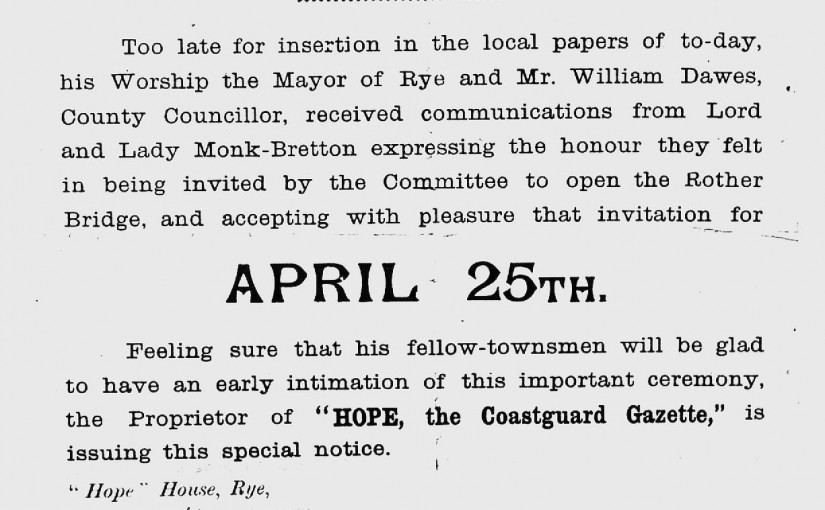By Laurie A. Cooksey
As early as 1876, the Highways Board had discussed the suggestion of constructing a bridge across the River Rother just below the the (then) single track swing bridge of the South Eastern Railway, together with a direct road to East Guldeford just over half a mile to the east of Rye, but although several meetings took place, the plans were dropped on the grounds of being too expensive. The matter was then taken up by the Rye & District Commercial Association, and the South Eastern Railway Company was approached by a deputation with a result that Sir Edward Watkin and Mr. Brady (engineer) from the railway company came down and met a deputation from the Rye Town Council and the Harbour Commissioners, but the suggestion was not adopted on account of the engineer to the Rother Level Commissioners declining to recommend other than a single span bridge being built in the place of the present railway swing bridge. The next move was made many years later by Alderman Selmes when he made what was to be an unsuccessful application to East Sussex County Council for a contribution of £200 towards the cost of the bridge. It was not until County Councillor C. H. Stenning invited his brother, County Alderman W. E. K. Stenning and several other members of the County Council to see for themselves the advantage of bringing the land belonging to the town on the Eastern side of the River from four miles distance to a few hundred yards that, a few months later, a contribution of £500 was granted without opposition. Meanwhile, Rye Town Council, seeing that the County Council was willing to help in the undertaking, agreed in 1890 to give the necessary land for the bridge and road (2000′ x 25′) for the sum of £750. Following this, a privately convened meeting of a few towns people resulted in a public meeting being held where it was proposed that the grant be increased to £1000, and this was later agreed by the Council. A further £250 was added later so that the bridge might be built “strong enough to bear a traction engine”. The finances eventually stood thus: Borough of Rye £1000, County Council £750, landowners by voluntary rate, £1037. 8s. 6d. and subscriptions, about £260, making a total of around £3,047. The entire expenditure of the bridge and the road amounted to £3,160, resulting in a deficit of about £113. (1)
The long awaited 140′ bridge was opened with much pomp and ceremony on Tuesday, 25th. April, 1893. Carried on two sets of piles, it had been constructed by Messrs. A. E. Munn of Tenterden, with the ironwork supplied by Messrs. Brettle & Co. Lady Monkbretton was, unfortunately, unable to attend the ceremony owing to illness and her daughter, the Hon. Miss Dodson took her place, declaring the bridge open to much applause by cutting a broad red ribbon (that had been stretched across the structure) with a pair of silver scissors. Mr William Dawes, in a short speech, went on to say that if it were not deemed presumptuous, he would like it to be called “Monk-Bretton Bridge” and that the family motto “Nurmine benigno enisus” be placed on each side.
In reply Lord Monk-Bretton said that the bridge and road had reduced a number of miles into an equal number of furlongs, and it had done more than that for the practical purposes of the town of Rye for it had passed two of those wonderful institutions – toll gates. He was glad to see the missing link between Kent and Sussex, and between the town of Rye and the lands on the eastern side of the Rother, and he was glad it had fallen to the lot of his daughter and himself to take part in the ceremony. He congratulated the Mayor of Rye (Alderman J. Symonds Vidler) and all those concerned on the completion of that work, and trusted they would reap the reward of their labours in the growth of traffic, the increased prosperity of the town, and in receiving grateful recognition of the credit which was due to them for the energy and exertions they had displayed to bring about the results they had met there to celebrate that day.(2)
(1) From a letter from John Neve Masters (Mayor of Rye) published in the Sussex Express & County Herald on Saturday, 3.11.94.
(2) South Eastern Advertiser, Saturday, 29.4.1893.
“Rye’s Own” September 2000
All articles, photographs and drawings on this web site are World Copyright Protected. No reproduction for publication without prior arrangement. © World Copyright 2015 Cinque Ports Magazines Rye Ltd., Guinea Hall Lodge Sellindge TN25 6EG
